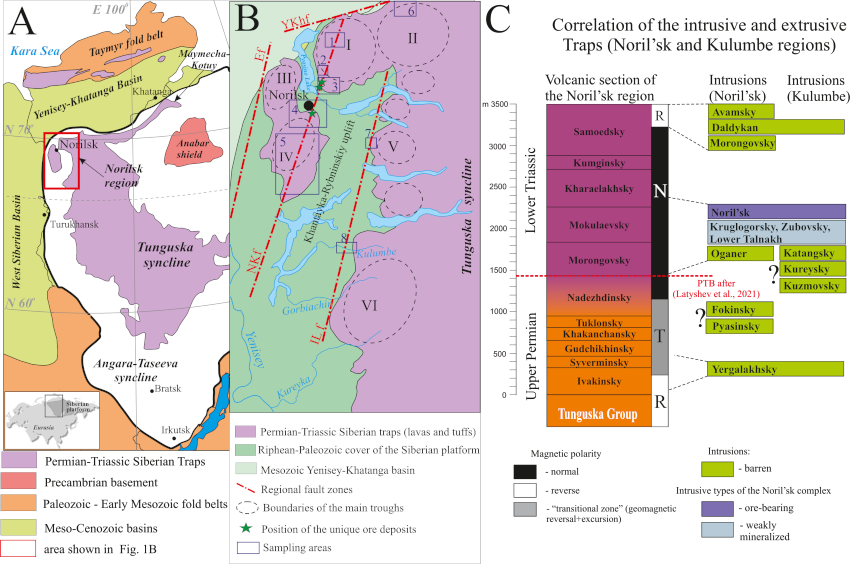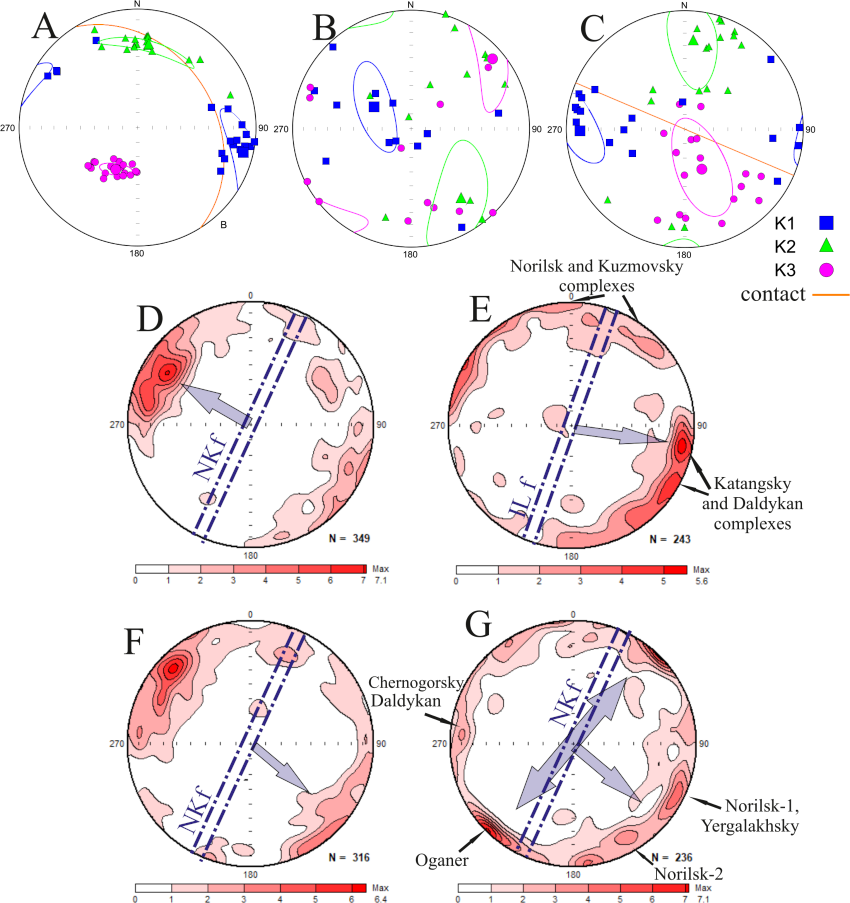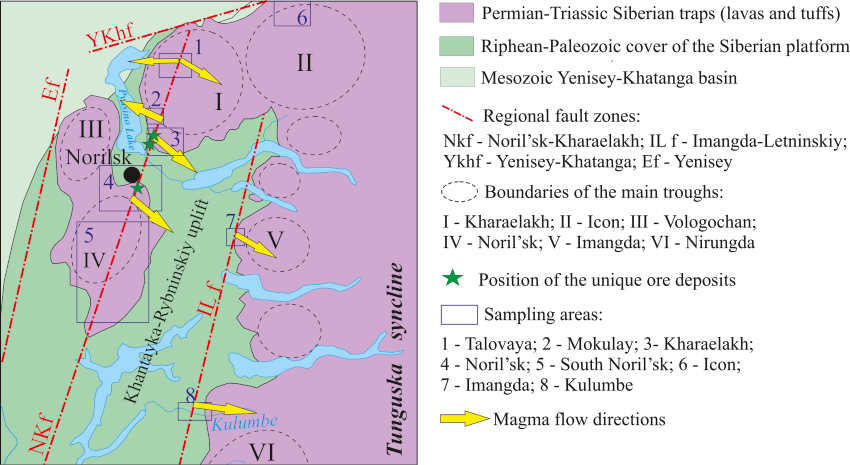March 2023 LIP of the Month
Reconstruction of the Magma Transport Patterns in the Siberian Traps from the Northwestern Siberian Platform on the Basis of Magnetic Fabric Data
Anton Latyshev1,2,*, Victor Radko3, Roman Veselovskiy1,2, Anna Fetisova1,2, Nadezhda Krivolutskaya4, Sofia Fursova1,2
1Schmidt Institute of the Physics of the Earth, Russian Academy of Sciences, Moscow, Russia;
2Faculty of Geology, Lomonosov Moscow State University, Moscow, Russia;
3Noril’skgeologiya LLC, Saint Petersburg, Russia;
4Vernadsky Institute of Geochemistry and Analytical Chemistry, Russian Academy of Sciences, Moscow, Russia;
*Corresponding author: anton.latyshev@gmail.com
Extracted and modified from: Latyshev, A.; Radko, V.; Veselovskiy, R.; Fetisova, A.; Krivolutskaya, N.; Fursova, S. Reconstruction of the Magma Transport Patterns in the Permian-Triassic Siberian Traps from the Northwestern Siberian Platform on the Basis of Anisotropy of Magnetic Susceptibility Data. Minerals 2023, 13, 446. https://doi.org/10.3390/min13030446
Introduction
Patterns of magma transport during the emplacement of Large Igneous Provinces (LIPs) are extremely important for the understanding of their formation. The Permian-Triassic Siberian Traps LIP is considered to be one of the largest in the Phanerozoic; however, mechanisms of magma transfer within and under the crust are still poorly studied. This problem is vital for the reconstruction of the dynamics of magmatic activity and eruption styles, ascertaining the position of magmatic centers and feeding zones, and conception of ore deposits genesis.
The Noril’sk region is the most studied area within the Siberian Traps, due to the presence of the unique Cu-Ni-PGE deposits, related to layered intrusions. However, despite the long investigation of the Noril’sk region, patterns of the magma flow during the emplacement of Traps in this area are poorly constrained (Callot et al., 2004). Here, we present the detailed results of anisotropy of magnetic susceptibility measurements for lava flows and intrusions from the Noril’sk and Kulumbe regions (the northwestern Siberian platform).
In total, we collected oriented samples at 195 sites, representing intrusions and lava flows from the northwestern Siberian platform. Sampling areas are shown in Fig. 1. Thick lava sequences from the upper part of the Noril’sk volcanic pile were studied in the Mokulay and Talovaya areas. Layered ore-bearing intrusions, their satellites, and small dikes and sills from other intrusive complexes were sampled in the Kharaelakh, Noril’sk, Kulumbe and Imangda areas. Finally, few intrusive bodies were studied in the Icon and South Noril’sk areas.

Fig. 1. (A) Sketch map of the Siberian Traps within the Siberian platform and surrounding areas. (B) Position of the studied areas. Regional faults: NKf—Noril’sk-Kharaelakh fault, ILf—Imangda-Letninskiy fault, Ef—Yenisey fault, YKhf—Yenisey-Khatanga fault; main troughs: I—Kharaelakh, II—Icon, III—Vologochan, IV—Nori’lsk, V—Imangda, VI—Nirungda; sampling areas: 1—Talovaya, 2—Mokulay, 3—Kharaelakh, 4—Noril’sk, 5—South Noril’sk, 6—Icon, 7—Imangda, 8—Kulumbe. (C) Correlation scheme of the intrusive and extrusive Siberian Traps for the Noril’sk and Kulumbe regions. PTB—Permian-Triassic boundary; magnetic stratigraphy and correlation scheme modified after (Latyshev et al., 2020; 2021).
We collected from 8 to 20 oriented samples (drill cores or hand blocks) per site. For all samples, anisotropy of magnetic susceptibility (AMS) was measured by the kappa-bridge MFK-1FA (AGICO). We also performed measurements of the anisotropy of anhysteretic remanent magnetization (AARM) for the selected sites and carried out the detailed rock-magnetic investigation, to reveal the features of magnetic mineralogy.
Results
The majority of studied rocks have a low degree of anisotropy of magnetic susceptibility Pj (usually less than 1.06). Absence of the strong metamorphic alteration and signs of deformations, and low AMS point out the magmatic genesis of the magnetic fabric. Exclusions are highly anisotropic sulfide-bearing rocks of the Noril’sk and Talnakh intrusions, massive sulfide ores, and hornfels with superimposed magnetic fabric, affected by the emplacement of nearby intrusions.
The normal type of magnetic fabric (N-type), when the minimal axis of the AMS ellipsoid (K3) is orthogonal to the contact of lava flow or intrusion and two other axes lie in the plane of the magmatic body, was identified for 102 sites (~52%). The major part of lava flows from the Talovaya and Mokulay sections, and many sill-like intrusions from different regions, demonstrate this type of magnetic fabric (Fig. 2A). Furthermore, we identified an inverse, or reverse type of magnetic fabric (R-type, K1 axis is orthogonal to the contact) in 33 sites (Fig. 2B), and an intermediate fabric (I-type, K2 axis is orthogonal to the contact) in 17 sites (Fig. 2C). In the remaining 42 sites (22%), axes of the AMS ellipsoid are either scattered (S-type) or diagonal (D-type) to the contact of intrusion. We selected sites with N-type of magnetic fabric and without notable amount of iron sulfides, and used the magnetic lineation (K1 axis of AMS ellipsoid) as the magma flow orientation, following (Ernst and Baragar, 1991; Raposo and Ernesto, 1995; Varga et al., 1998; and many others).

Fig. 2. A-C. Examples of AMS ellipsoid for sites with various magnetic fabrics. Geographic coordinate system. (A) Mokulaevsky Formation, basaltic lava flow, N-type. (B) Sill of the Yergalakhsky complex, trachydolerites, R-type. (C). D-G. Contour plots of the maximal axis K1 of AMS for the selected regions. Lower hemisphere, equal area projection. (D) Mokulay, tilt-corrected; (E) Kulumbe; (F) Kharaelakh; (G) Noril’sk. Arrows show directions of the magma transport. NKf—Noril’sk-Kharaelakh fault; ILf—Imangda-Letninskiy fault.
Based on rock-magnetic features, all samples from different intrusions can be divided into three groups: (1) lava flows and barren or weakly mineralized intrusions with magnetite or titanomagnetite as the main magnetic carrier; (2) sulfide-bearing rocks of layered intrusions and massive sulfide ores; and (3) weakly magnetic samples from hornfels, leucogabbro and other rocks, with high proportion of paramagnetic minerals. Samples of the first rock-magnetic group usually provide the clear magnetic fabric of N-type. Measurements of AARM for the selected sites showed that in some cases the inversion of AMS ellipsoid (R- and I-type magnetic fabric is caused by features of the domain structure of magnetite or titanomagnetite.
Discussion
In six of the studied areas, we distinguished predominant NW or SE directions of magma transport, transverse to the regional Noril’sk-Kharaelakh and Imangda-Letninskiy fault zones. For the Mokulaevsky, Kharaelakhsky, and Samoedsky formations, we suggest the motion of lava flows to the NW and SE from the Noril’sk-Kharaelakh fault during the fissure eruptions (Fig. 2D). For the major parts of intrusions in the Noril’sk, Kharaelakh, and Imangda troughs and the Kulumbe area, the reconstructed pattern of magma transport supports the idea of the magma-controlling and magma-feeding role of regional fault zones of NE strike (Fig. 2 E-F). This is important for the understanding of Cu-Ni-PGE ore genesis because in all studied regions, layered intrusions with mineral deposits are located at fault zones: Talnakh and Kharaelakh intrusions in the Kharaelakh trough, Noril’sk-1 and its satellites in the Noril’sk trough, the Imangda intrusion in the same-titled trough, and the Siluriyskaya intrusion in the Kulumbe area.
Minor directions of the magma transport correspond to the emplacement of individual intrusions during distinct magmatic events, e.g., formation of the Oganer sill (Fig. 2G). In addition, in some regions, the lateral transport along the fault zones was identified based on the NE orientation of magnetic lineation (Fig. 2E).
Patterns of magma transport in the Noril’sk and Kulumbe regions differ sharply from that in the Angara-Taseeva depression (Latyshev et al., 2019), where lateral transport of magma via the system of sills led to the emplacement of thick and extended intrusions (the Tolstomysovsky, Padunsky sills, etc.). The possible reason is the different crust structure and tectonic evolution of these regions. The Noril’sk and Kulumbe regions are superimposed to the Noril’sk-Igarka paleorift zone, identified on the basis of geophysical data (Krivolutskaya et al., 2019). The Noril’sk-Kharaelakh and Imangda-Letninskiy faults extend along this structure and represent long-lived mobile zones of high permeability (Fig. 3). All economically important Cu-Ni-PGE deposits in the northwestern Siberian platform are located within these zones and are linked with the magma conduits. Proximity of the Noril’sk and Kulumbe regions to the supposed center of the Siberian plume (Sobolev et al., 2011) can lead to the activation of fault zones, ascent of large volumes of magma via the system of dikes (Ernst and Buchan, 2001), and fissure eruptions. In contrast, the Angara-Taseeva depression is a Paleozoic sedimentary basin within the Siberian platform, and the magma-feeding zone was located in the central, most subsided part of the syncline. The peripheral position of the Angara-Taseeva depression and absence of regional extension zones led to the reduced thickness of the volcanic sequence compared with the Noril’sk region.

Fig. 3. Reconstructed directions of the magma transport in the northwestern Siberian platform.
Conclusions
- Based on the detailed AMS measurements, we reconstructed the magma transport patterns for the Siberian Traps in the Noril’sk and Kulumbe regions (northwestern Siberian platform). The lateral flow of NW-SE directions is predominant in most areas, supporting the model of a magma-feeding and ore-controlling role of the Noril’sk-Kharaelakh and Imangda-Letninskiy faults, as well as fissure type of lava eruptions.
- Minor directions of SW-NE strike are identified in several areas, indicating the transport of magma along regional faults.
- Lava flows and thin sills usually demonstrate N-type of magnetic fabric and are suitable for the determination of magma flow. Layered ore-bearing intrusions often show complicated magnetic fabric due to the complex morphology and presence of iron sulfides. Abnormal magnetic fabric in some intrusions and lava flows can be explained by features of domain composition of magnetite or titanomagnetite.
- Patterns of magma transport for the Noril’sk-Kulumbe region and Angara-Taseeva depression (the southern part of the Siberian platform) are contrasting due to the different tectonic structure of the crust.
Acknowledgements
This study was funded by Limited Liability Company “Noril’skgeologiya”, by the Russian Foundation for Basic Research (projects 18-35-20058, 17-05-01121, 18-05-70094 and 20-05-00573) and by state assignment of IPE RAS. Authors gratefully thank A.A. Lapkovsky and A.A. Ketrov (Noril’skgeologiya) for the help during field work and V.E. Pavlov, A.M. Pasenko, P.S. Ulyakhina, D.V. Rud’ko, P.A. Minaev, and E.A. Latanova (IPE RAS) for the participation in sampling, measurements, and processing of the results. We especially thank Richard Ernst for his invitation to prepare this LIP of the Month.
References:
Callot, J.-P.; Gurevitch, E.; Westphal, M.; Pozzi, J.-P. Flow patterns in the Siberian traps deduced from magnetic fabric studies. Geophys. J. Int. 2004, 156, 426–430.
Ernst, R.E.; Baragar, W.R.A. Evidence from magnetic fabric for the flow pattern of magma in the Mackenzie giant radiating dyke swarm. Nature 1992, 356, 511–513.
Ernst, R.E.; Buchan, K.L. The use of mafic dike swarms in identifying and locating mantle plumes. Geological Society of America Special Papers 2001, 352, 247-265.
Krivolutskaya, N.A.; Latyshev, A.V.; Dolgal, A.S.; Gongalsky, B.I.; Makarieva, E.M.; Makariev, A.A.; Svirskaya, N.M.; Bychkova, Y.V.; Yakushev, A.I.; Asavin, A.M. Unique PGE–Cu–Ni Noril’sk deposits, Siberian Trap Province: Magmatic and tectonic factors in their origin. Minerals 2019, 9, 66.
Latyshev, A.V., Ulyakhina, P.S., Veselovskiy, R.V. Reconstruction of magma flow in Permo–Triassic intrusions of the Angara–Taseeva syneclise (Siberian platform) based on magnetic susceptibility anisotropy data. Russian Geology and Geophysics. 2019. 60 (4), 400–413.
Latyshev, A.V.; Radko, V.A.; Veselovskiy, R.V.; Fetisova, A.M.; Pavlov, V.E. Correlation of the Permian-Triassic ore-bearing intrusions of the Noril’sk region with the volcanic sequence of the Siberian Traps based on the paleomagnetic data. Econ. Geol. 2020, 115, 1173–1193.
Latyshev, A.V.; Krivolutskaya, N.A.; Ulyakhina, P.S.; Fetisova, A.M.; Veselovskiy, R.V.; Pasenko, A.M.; Khotylev, A.; Anosova, M.B. Paleomagnetism of the Permian-Triassic intrusions from the Noril’sk region (the Siberian Platform, Russia): Implications for the timing and correlation of magmatic events, and magmatic evolution. J. Asian Earth Sci. 2021, 217, 104858.
Raposo, M.I.B.; Ernesto, M. Anisotropy of magnetic susceptibility in the Ponta Grossa dike swarm (Brazil) and its relationship with magma flow directions. Phys. Earth Planet. Inter. 1995, 102, 183–196.
Sobolev, S.V.; Sobolev, A.V.; Kuzmin, D.V.; Krivolutskaya, N.A.; Petrunin, A.G.; Arndt, N.T.; Radko, V.A.; Vasil’yev, Y.R. Linking mantle plumes, large igneous provinces, and environmental catastrophes. Nature 2011, 477, 312–316.
Varga, J.V.; Gee, J.S.; Staudigel, H.; Tauxe, L. Dike surface lineations as magma flow indicators within the sheeted dike complex of the Troodos Ophiolite, Cyprus. J. Geophys. Res. 1998, 103, 5241–5256.
